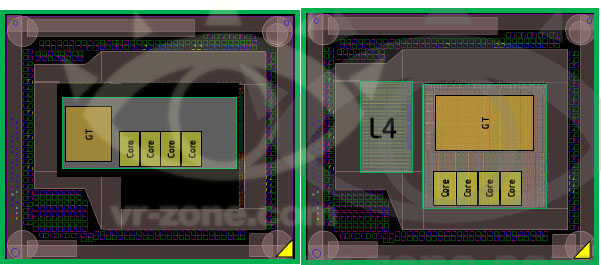With Haswell, Intel will go back to a MCM solution where it combines two different circuits in one and the same package, and once more it is the graphics circuit in focus. With a fourth level of cache Intel hopes to boost performance substantially.
Rumors surrounding Haswell have been many, especially with the graphics processor in mind. Some sources have claimed a marginal boost from Ivy Bridge, while other claim a huge boost. It turns out both may be right, thanks to a new dedicated cache for the graphics processor. This will only apply to the top models, and not all Haswell based processors.
Haswell are expected to arrive in several different combinations, with two or four processor cores, and the graphics in three different configurations: GT1, GT2 and GT3. Sandy Bridge only has two options for the graphic side of things: GT1 and GT2 with 6 and 12 units respectively (with Ivy Bridge it will be 6 and 16), also known as EU as in Execution Unit. Haswell takes things one step further with GT3, which is expected to double up from the GT2 configuration it will also offer. Earlier rumors have spoken of 40 execution units. The integrated graphics in Haswell will put a large focus on acceleration of applications for cheaper workstations, and Intel hopes to be able to compete with discrete solutions like NVIDIA Quadro and AMD FirePro.
 Haswell on the right gets four cores, GT3 graphics and dedicated L4 cache
Haswell on the right gets four cores, GT3 graphics and dedicated L4 cache
The GT3 configuration will be in need of extra bandwidth and share it with four processor cores is not a good option. Therefore Haswell with GT3 graphics will get L4 cache that is dedicated to the graphics circuit, for extra bandwidth. Besides being of great assistance in professional applications, it should also come to good use in games. Other than that the chip is expected to be identical to Ivy Bridge (Gen 7) looking strictly at the architecture, and it will be the number of units and the clock frequencies that will make Haswell faster (Gen 7+).
It is still unclear if Haswell for Ultrabooks will get GT3 graphics and the dedicated L4 cache. The problem we see is that the graphics circuit will contribute to more than just a better experience, but also drain the battery, but this is too early to speculate. Will Haswell be the first processor from Intel where the integrated graphics processor can seriously compete with AMD that is expected to release the third generation APU about the same time as Haswell?
Source: VR-Zone














